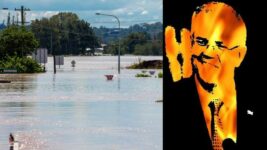How Good Are Rain Bombs and Megafires? Morrison Damns Us to Climate Hell

“Rain bombs” have been devastating the eastern board of Australia over the last week. These unprecedented downpours, which have destroyed entire towns, taken numerous lives, and are about to pound some of the most heavily devastated areas once more, are obviously climate-driven.
These unparalleled levels of water gushing down from the heavens, washing away the lifetimes of many, were witnessed in the northern hemisphere just months ago, whilst we were all in lockdown.
Germany and Belgium were smashed like this last year, as were Canada and China’s Henan province.
The extreme weather events that the eastern states of Australia are experiencing are occurring just 24 months after never-before-seen megafires burnt 20 percent of this continent’s bushland to the ground, and that came on the back of a prolonged drought in the very same areas now underwater.
Scientists have been warning for decades that these catastrophic weather events were coming. Yet, despite the onslaught of one climate disaster after another, not only on our doorsteps, but simultaneously and persistently around the planet, climate deniers still reign in positions of power.
As Lismore became an inland sea, NSW premier Dominic Perrottet called the floods a “one-in-a-thousand-year-event”, even though this has been mirrored repeatedly around the globe of late. But he’s made clear he doesn’t believe in “man-made climate change”. And as for the PM, well…

Dearth followed by deluge
“If we listen to the locals commonly affected by floods, and we should, this is like nothing we’ve seen. This is the frontline of the climate emergency,” said science communicator Shannan Langford Salisbury. “We’re experiencing it right now – and we’re experiencing it across the entire east coast.”
“From my perspective as a water educator, the unprecedented rain and floods we’re seeing are our natural systems pushed to the edge. They’re more extreme and intense than normal cycles and we’re unprepared for it, despite 40 years of warnings,” she continued. “It’s so frustrating.”
Salisbury left her position as senior education officer at the Murray-Darling Basin Authority two years ago, after witnessing firsthand the devastation being wrought on the region by human activity during the prolonged drought that saw the Narran, Namoi and Barwon rivers run dry.
So, the former public servant joined the climate movement. And she’s recently turned film producer, as she oversaw the making of The Pilliga Project: a documentary outlining the destruction the Narrabri gas project is set to wreck on Gomeroi County in the Murray-Darling region.
Australian energy company Santos plans to drill 850 coal seam gas wells through the Great Artesian Basin, one of the world’s largest freshwater reserves. The Pilliga Project reveals that the grid of wells this will be created throughout the pristine forest will then grow exponentially across the region.
Right now, “my family is flooded into their property and my colleagues are affected”, Salisbury told Sydney Criminal Lawyers, in reference to what’s happening in northern NSW.
“It’s devastating. If we don’t act now, we’re facing a bleak future.”
“A dire warning”
The International Panel on Climate Change has just released its second instalment of its sixth assessment report. The IPCC’s evaluations continues to get bleaker with every release.
Last year’s instalment was described by UN secretary general António Guterres as “a code red for humanity”.
This time the United Nations body warns that the effects of climate change are progressing faster than expected, as Lismore residents are well aware. And extreme weather events are happening simultaneously, as evidenced by Canada’s quick succession of wildfires then floods last year.
The IPCC sets out that floods and fires, just like Australia has been recently experiencing, are set to continue on a grander scale as we careen towards a 1.5°C rise in temperatures, and if we hit higher, the more severe effects will be irreversible.
“People’s health, lives and livelihoods, as well as property and critical infrastructure, including energy and transportation systems, are being increasingly adversely affected,” the report authors write, which, again, could be directly referring to what’s occurring here.
We all know what Morrison does hold
Prime minister Scott Morrison has governed the country during a time of unprecedented catastrophes, which he’s repeatedly shrugged off as if they have no connection to the fossil fuel industry, in whose pocket he sits.
The Liberal leader even went on a holiday to Hawaii during the megafire crisis, only to return and claim he wasn’t needed, because he doesn’t “hold a hose, mate”. And just months later, he launched a massive nationwide gas expansion initiative, asserting it would pull us out of pandemic downturn.
Morrison and his fossil fuel cronies are absolutely aware that the extreme weather is being caused by the emissions produced via their mining and extraction. And it would seem that not only are they more concerned with profiteering, but they also believe there’s no other path bar destruction.
“We can act. There’s still time and a lot of things we can do,” Salisbury counters that reading of events. “It can be turned around. We can act on the climate emergency today to stop the planet warming to 3 or 4 degrees Celsius and avoid the worst of what’s to come.”
“I just want people to know that,” she added. “There’s still time and hope.”
System change
Indeed, the climate movement has been rapidly growing over recent years. Prior to the pandemic lockdowns, hundreds of thousands were taking to the streets calling for an end to fossil fuel harms and a just transition towards renewable energies, just as Singapore is attempting to do.
Unbeknownst to many, the Morrison government has given that tiny Southeast Asian nation the greenlight to build the largest solar powerplant on the globe in the Northern Territory, so that it can use this green energy to fuel 20 percent of its needs by six years’ time.
This development is occurring at the same time as the PM calls for a gas-fired recovery. This is the hypocrisy of our government.
Grassroots climate groups, like Extinction Rebellion, have swept onto the scene right across the world, making it known that we are facing a dire existential threat, which can be countered if people rise up and demand system change.
“We need people to come together, because together we have power. We need to come together in the streets, and we need to make our governments at every level – local, state and federal – act,” Salisbury said, and she cited the 25 March Global School Strike for Climate.
“I want people to keep pushing,” the scientist concluded. “This fight won’t be over until we reduce our emissions, and we need to push government and industry to do that now. It’s critical.”







